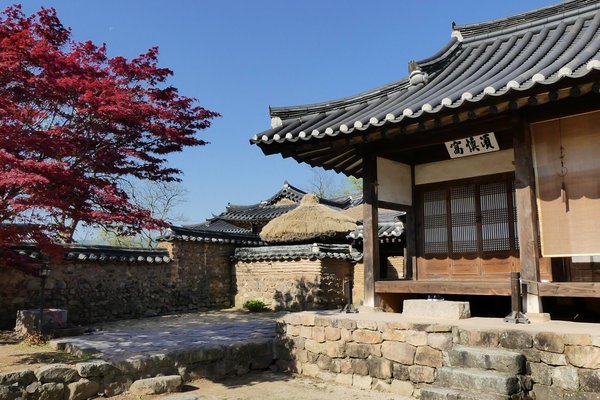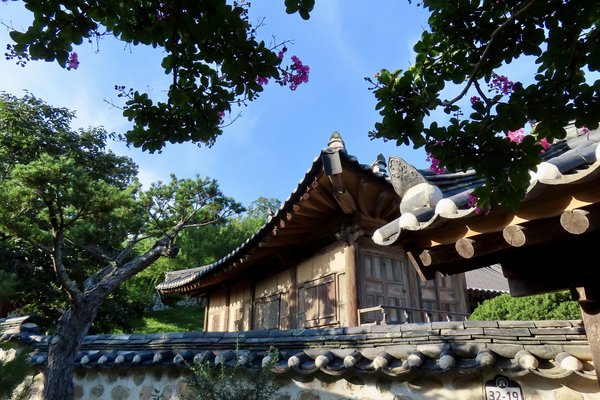Republic of Korea
Hahoe and Yangdong
Historic Villages of Korea: Hahoe and Yangdong comprise the two most representative historic clan villages in Korea.
They preserve Joseon-style architecture, folk traditions, valuable books, and the old tradition of clan-based villages. The layout of the settlements followed strict Confucian ideals. They include residences for the head families, mud-walled and thatch-roofed commoners houses and Confucian academies for learning.
Community Perspective: These are peaceful and well-preserved living villages, “with many lovely thatched roof houses, paddy rice fields, lotus ponds and blooming flowers”. They aren’t tourist traps (yet) filled with souvenir shops and restaurants. Clyde managed to stay overnight at the largest hanok, Bukchondaek.
Site Info
Official Information
- Full Name
- Historic Villages of Korea: Hahoe and Yangdong (ID: 1324)
- Country
- Republic of Korea
- Status
-
Inscribed 2010
Site history
History of Hahoe and Yangdong
- 2010: Advisory Body overruled
- ICOMOS advised Referral to "Put in place a coordinated management system for the two component sites"
- 2010: Inscribed
- Inscribed
- Type
- Cultural
- Criteria
- iii
- iv
- v
- vi
Links
- UNESCO
- whc.unesco.org
- Official
-
- english.visitkorea.or.kr — Visit Korea Yangdong
- hahoe.or.kr — About Hahoe Folk Village
All Links
UNESCO.org
- whc.unesco.org — whc.unesco.org/
Official Website
- english.visitkorea.or.kr — Visit Korea Yangdong
- hahoe.or.kr — About Hahoe Folk Village
News Article
- March 26, 2025 biz.chosun.com — Wildfire nears Hahoe Village, UNESCO site, prompting increased fire response
- Oct. 18, 2011 koreatimes.co.kr — Andong Hahoe Village, which was designated UNESCO World Heritage Siteslast year, and since then has seen numerous visitors. The village, however, is struggling to maintain its traditional way of life with the rise in the number of visitors.
Community Information
- Community Category
- Urban landscape: Asian
Travel Information
Exact locations inscribed twice (or more)
WHS Commandments Stars
All 10 criteria, plus both villages include maps/brochures with English descriptions of the village …
Gyeongju hotspot
Recent Connections
-
WHS Commandments Stars
All 10 criteria, plus both villages inc…
-
Exact locations inscribed twice (or more)
Historic Villages of Korea: Hahoe and Y… -
Confucian Academy (Shuyuan, Seowon, Shijuku)
Byeongsan-seowon and Oksan-seowon
Connections of Hahoe and Yangdong
- History
- Architecture
-
-
Timber framing
"The villages were located to provide both physical and spiritual nourishment from their surrounding landscapes. They include the residences of the head families, together with substantial timber framed houses of other clan members." - AB Document -
Vernacular architecture
-
Wooden architecture
-
Geomancy
"The two villages faithfully follow pungsu principle (traditional siting principle, feng shui in Chinese), in village construction. One sits along a river and one at the foot of mountains, thus demonstrating best examples of desirable clan village locations." - Nomination File -
Earth Architecture
Most of lower class houses in Yangdong are mud wall house
-
- World Heritage Process
-
-
Exact locations inscribed twice (or more)
Historic Villages of Korea: Hahoe and Yangdong (Byeongsan-seowon and Oksan-seowon) Seowon, Korean Neo-Confucian Academies (Byeongsan-seowon, Oksan-seowon,)
-
- Religion and Belief
-
-
Confucianism
the Confucian Academies -
Legends and Folk Myths
Held as a divine tree in the center of the village. The spirit shrine is called Samsindang. Residents of the town believe the 600-year-old zelkova tree aids fertility and good luck
-
- Human Activity
-
-
Protective engineering works against flooding
"In Yangdong Village, the houses at the foot of the mountain are not seriously exposed to flood disaster, but the farm lands at the center of the village were likely to be inundated if Allakcheon Stream flooded. Consequently in 1994, the 300m-long and 5m-high dike between Allakcheon Stream and the village was constructed and its drainage system was built to protect the village from any kind of flood disaster." - Nomination File -
Festivals
Andong Mask Dance Festival (Held annually in the Fall) -
Irrigation and drainage
"The nominated area includes fields bordering the river between the village and the lower slopes of the mountain. They are primarily irrigated rice paddies." - AB Document -
Masks
Hahoe Byeolsingut Tallori (Masked-dance Drama of Hahoe Village, Important Intangible Cultural Property No. 69)- Nomination File
-
- Constructions
-
-
Cultural sites connected to Cliffs
Hahoe and Yangdong "Gyeomamjeongsa Study Hall was built in 1567 by Ryu Ul-lyong. Set on the western end of the Buyongdae Cliff it is framed by pine forest, and has picturesque views out over the Hwacheon Stream to the hills beyond." "Wonjijeongsa Study Hall was built in 1576 by Ryu Seong-ryong on the edge of the river for his own study and for teaching. It consists of a study hall and an elevated square pavilion, from which there are views out across the river to the pine forests of Buyongdae Cliff and beyond to Mount Wonjisan."
-
- WHS on Other Lists
-
-
Memory of the World
Confucian Woodblock Prints (2015): The Confucian Academies in Korea, particularly in North Gyeongsang province played a huge role in the publication, storage, and gathering of . Inscribed within the Historic Villages of Korea WHS - Byeongsanseowon Confucian Academy - Oksanseowon Confucian Academy - Donggangseowon Confucian Academy The current collection is now housed in Andong, it used to be largely stored in the Confucian Academies themselves.See www.unesco.org
-
- Timeline
-
-
Built in the 14th century
Hahoe and Yangdong in their landscape settings are seen as the two most representative historic, clan villages in Korea. They were founded in the 14th-15th century and subsequently expanded to their present size and composition in the late 18th and 19th centuriesSee jikimi.cha.go.kr
-
- WHS Hotspots
-
-
Gyeongju hotspot
< than 25km from Yangdong Village
-
- Science and Technology
-
-
Confucian Academy (Shuyuan, Seowon, Shijuku)
Byeongsan-seowon and Oksan-seowon -
Libraries
Included in the nominated property are three Confucian academies Byeongsanseowon, Oksanseowon, and Donggangseowon. "Seowon, or a Confucian academy was a private educational institution set up exclusively for a man who had achieved outstanding learning and virtue. Its twin roles of enshrining a specific sage and educating students were reflected in its components: shrine, jeonsacheong, a building for the preparation of memorial rites, lecture hall, students' quarters (jaesa), library (jangpangak), and an elevated pavilion (nugak) where Confucian scholars held gatherings or took rests." - Advisory Body Evaluation
-
- Visiting conditions
-
-
WHS Commandments Stars
All 10 criteria, plus both villages include maps/brochures with English descriptions of the village and clear boundaries of the village. Paper ticket stubs are provided that include UNESCO symbol, view of the village, date, and cost. UNESCO plaques are prominently displayed.
-
- Literature & Film
-
-
Poetic Quotations
16 Beautiful Sceneries along the River by Ryu Won-ji written in the early 17th century.(Part eight) "The People Walking on the Lane along the Cliff. Outside the village there is a lane along the cliff. I see several passers-by. I do not know where they are heading. I often see them coming and going. Against the drizzle, they wear straw rain capes. In the sunset, they carry firewood on their backs. The trail is too dangerous for them to rest their shoulders. The river has mysterious depth. A few people ask to be ferried across. Sitting quietly, I compare busyness with leisure. Doing nothing will be comfortable." - -
Literature
Hahoe Village: Criterion (iv): The villages, and particularly the ensemble of yangban and commoners' houses, and their overall and individual planning, reflect the precepts of this Dynasty in terms of its social structures and cultural traditions as well as its power and influence and its literary, and philosophical traditions.
-
News
- biz.chosun.com 03/26/2025
- Wildfire nears Hahoe Village, UNES…
- koreatimes.co.kr 10/18/2011
- Andong Hahoe Village, which was de…
Recent Visitors
Visitors of Hahoe and Yangdong
- AC
- Alexander Lehmann
- Alexander Parsons
- Alex Goh
- anthonybonbon
- Atila Ege
- Badwater
- Bernard Joseph Esposo Guerrero
- Bigboss99
- Bill Maurmann
- bossc
- Bram de Bruin
- c82wc1
- Can SARICA
- Casey
- Chalamphol Therakul
- Chantal den Haan
- chenboada
- Cheryl
- Christoph
- Christravelblog
- Clyde
- Colossus
- CugelVance
- cutecid
- cwthong
- Dimitar Krastev
- DouglasR
- Dr. Caligari
- eljx1988
- Els Slots
- Erik Jelinek
- Errol Neo
- Eva Kisgyorgy
- Fan Yibo
- Frederik Dawson
- GabLabCebu
- Garrett
- Hadrianus
- Harry Mitsidis
- Hdwilsonau
- henrik_hannfors
- henryjiao18
- Iain Jackson
- Ian Cade
- inomusay
- Jacob Choi
- Janos
- Jarek Pokrzywnicki
- Javier
- Jeffrey Chai
- JL
- João Aender
- Joel on the Road
- Jonas Kremer
- Jon Eshuijs
- Joyce van Soest
- jxrocky
- Kasper
- Ken DJ
- Kristin
- krtek
- Kyle Magnuson
- lichia
- Luboang
- Ludvan
- Lukasz Palczewski
- Luke LOU
- Maciej Gil
- Malgorzata Kopczynska
- MaYumin
- Michael Ayers
- Michael Novins
- Michael Turtle
- Miguel Marquez
- Mihai Dascalu
- Mikan22
- Miloš Tašković
- Nafis N
- nan
- Niall Sclater
- Nihal Ege
- Nuria8
- Patrik
- Paul Schofield
- Pchxiao
- Petteri
- Philipp Peterer
- ReallyDeepThoughts
- Reza
- Rob Wilson
- Roman Bruehwiler
- Sclowitz
- Sergio Arjona
- Shandos Cleaver
- sibariam
- Simonh
- Slavi
- Solivagant
- Stanislaw Warwas
- Stijn
- Szucs Tamas
- Taotao Chen
- Thomas Buechler
- Thomas van der Walt
- tony0001
- Vincent Cheung
- voyager
- Walter
- Xiong Wei
- Xiquinho Silva
- Zach
- Zoë Sheng
- Zos M
- ZZSong
Community Reviews
Show full reviewsKyle Magnuson
Historic Clan Villages of the Yangban (Joseon Aristocrats)
Hahoe and Yangdong (Inscribed)
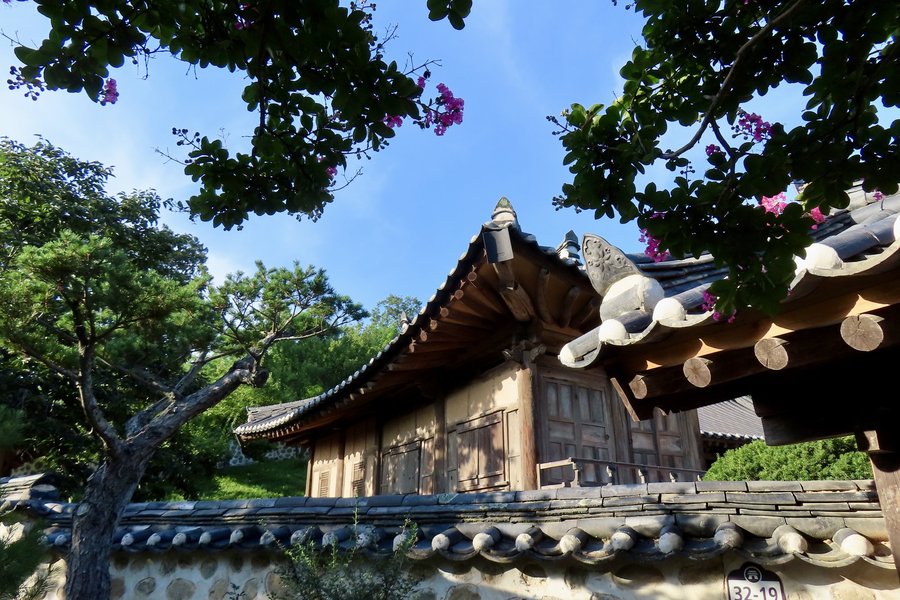
I believe I might be the only person since Els who visited both villages (at least among the reviewers). I visited Hahoe (Andong) in 2011, just after inscription and now I've completed the set with a visit to Yangdong (Gyeongju) in 2025. I will only cover the two villages, as the key associated Seowon (Oksan, Byeongsan) were inscribed again in 2019. Yangdong has been made modestly accessible to visitors (visitor center / museum), while maintaining its traditional character. Tourist trap, Yangdong is surely not. When you have infrequent buses in Korea, this will prevent the vast majority of city-dwellers from venturing out to the countryside. Therefore, I believe Yangdong specifically will not be overwhelmed by tourism in the foreseeable future. Moreover, the iconic sites of Gyeongju are nearby, which pre-occupies most domestic tourists.
Hahoe & Yangdong Village (Collage)
Once you receive your ticket (WHS memento) at either village, you will be given a map. My advice (which is reflected in other reviews as well) is mark a couple key places as destinations to walk toward and then simply go explore. You might not see all of the best-preserved historic houses (if your time is restricted to 1-2 hours), but you will surely get a sense of the village and what makes it special.
Some of the best Yangban houses have been designated as treasures, making them ideal destinations within the village.
Treasure Designations
Yangdong Village
Mucheomdang House (Treasure)
Hyangdan House (Treasure)
Gwangajeong House (Treasure)
Hahoe Village
Yangjindang House (Treasure)
Keep reading 0 comments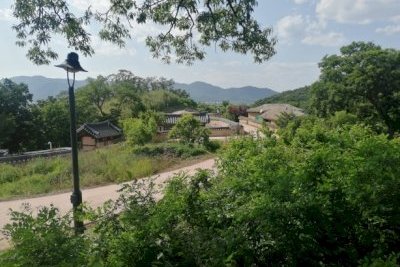
Hahoe and Yangdong are known and advertised as villages with a lot to them - they're clan villages that have been perfectly preserved to demonstrate rural life over 5 centuries of habitation and growth; "in their siting, planning, and building traditions, the two villages are an exceptional testimony to the Confucianism of the Joseon dynasty." Thus, the divisions of the historic houses into servants', women's, and men's quarters, as well as the layout of the villages with houses of the clan leaders behind the hills while the houses of the lower class are closer to the entrance, all of these principles in practice are things I kept in mind to observe as I made my way towards Yangdong in June 2023. However, after my visit, I would say the best way to explore this village and have the most enjoyable experience there is by wandering around aimlessly, enjoying the historical atmosphere and the cool countryside air. Yangdong is a place to get lost in, and I wish I had the luxury of time to do just that, but alas, I had a bus to catch to Busan that night. Nevertheless, I got my fair share of wandering while also getting to tour some of the most important sites.
Actually, my visit to the Yangdong portion of the World Heritage Site started with Oksan Seowon, which I review in the Seowon page. After that, the same bus #203 took me to Yangdong in about 15 minutes (this is around 45 …
Keep reading 0 comments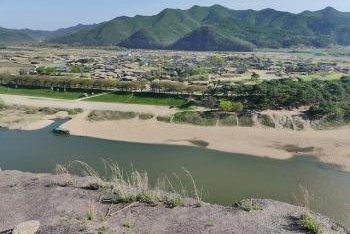
I visited this WHS in April 2017. In Seoul I caught the Line 2 subway to Kangbyun Station. From Exit 3, I headed to the East Seoul Bus Terminal and bought an intercity bus (Tago) to Andong for 17100 won (2hrs 40mins) instead of a Korail train ticket which strangely enough takes longer (3hrs 15mins) and costs around 24000 won. Arriving quite late in the afternoon and travelling with luggages, we decided to catch a 30 minute taxi instead of waiting for the 50 minute bus ride to Hahoe and having to walk to our hanok. This way we also avoided paying the 3000 won entrance fee since we were sleeping there and got there in time for a splendid sunset. For dinner we had the local speciality, Andong-jjimdak (steamed chicken and glass noodles with various vegetables marinated in a ganjang based sauce) and a shot of Cho Ok Hwa folk liquor or Andong soju.
Hahoe Folk Village is made up of 9 tile-roofed noble houses or hanoks and 29 thatched cottages. To be able to beat the day tour buses (even on weekdays!) and to experience the old hanok interiors, we booked in advance to stay at the largest hanok and registered cultural heritage, Bukchondaek, built by the provincial governor Ryu Doseong in 1862 and owned by the same family ever since. We had the privilege not only to eat, sleep and stay inside the hanok but also to have a private tour inside the oldest part of the …
Keep reading 0 comments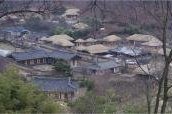
Yangdong and Hahoe Folk Villages are traditional and historic Korean villages mostly occupied since the Joseon Dynasty. For now, I have only visited the Yangdong village, located 16 kilometers of the historic city of Gyeongju. Korean aristocracy was living here under the Joseon Dynasty. The village comprises several Korean National Treasures.
Although some part of the village are unoccupied nowadays most of the folk homes are still used. Fifty-four historic homes are more than 200 years old. Mostly located on the side of a hill and on the bottom, this village is a fine example of Joseon Dynasty architecture and traditions.
To get to this village, take one of the several different buses going from Gyeongju bus terminal to Yangdong village in almost one hour.
Keep reading 0 comments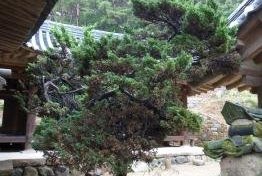
I must admit when I first arrived at Yangdong I was distinctly unimpressed. Bus 203 dropped me off in a rather muddy car park and I was left looking through the drizzle at some tour groups walking around a cluster of wooden houses on a small hill.
I walked around these houses for a couple of minutes and wondered if this was all there was to see. Fortunately a friendly local gave me a map of the village and I realised it was actually much larger, so off I trotted over the hill to investigate further. I enjoyed looking into some of the houses that were open and visiting the ‘Folk Treasures’ Seobaekdang was my favourite. All in all it was a pleasant place to stroll around and relax but there was not a huge amount to do.
This was the second "folk village" I have visited from the World Heritage list and I was left with a similar feeling that I had after calling into Holasovice, it is nice that there are some representations of low key rural life on the list (even if this particular village was more for the rural elite) however they are not the most impressive places to visit.
I visited Yangdong on a morning sojourn from Gyongju and it was a nice trip. There is now a direct bus that runs up there from the city centre every 90 minutes. It seems that the village is transforming into more of a tourist destination …
Keep reading 0 comments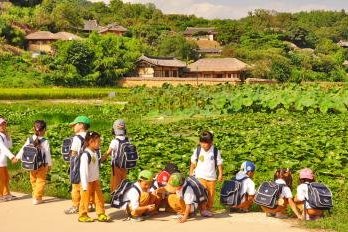
During my short trip to South Korea, I have a chance to revisit Gyeongju and its two UNESCO protected sites, Bulguksa Temple and Gyeongju Tumuli Park; however my true highlight was a visit to Yangdong, a small village outside the city of Gyeongju, together with Hohoe became the third world heritage site of Gyeongsangbuk-do Province, one of the cultural hotspot of this country. By a nice direct bus no. 203 from the Sin-Gyeongju Train Station or the central bus terminal, I was in Yangdong within 40 minutes. The first thing I saw was the large parking zone, with five tourist buses, clearly Yangdong was already being on tourist itinerary.
The village itself is beautiful with many lovely thatched roof houses, paddy rice fields, lotus ponds and blooming flower, one of the prettiest places in Korea. Strolling around the village is a thing to do, as the village has unique characteristic as the tiled roof house of the ruling class will be on the top of the hill, while the lower class thatched roof houses are built on the ground below; however most of the houses are still occupied by local people, few are opened for sightseers, but I loved these things, the village is still a living place, not a fake traditional villages which Korea has a lot and also Yangdong does not have ticket for entrance yet.
I don’t know what will happen with Yangdong in the near future, the site has potential to become a new …
Keep reading 0 comments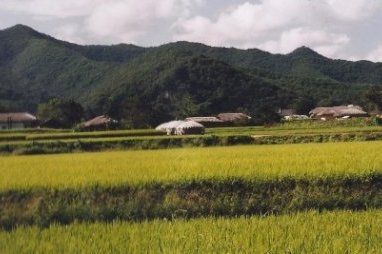
On my trip to South Korea in 2001, a trip that lasted only 2 weeks, I visited the country's all 8 WHS. And a number of other nice places - the distances within South Korea aren't that far, and it's an easy and rewarding place to travel in. Two of these sites now have become a WHS in 2010: Hahoe Folk Village and Yangdong Folk Village.
The bus ride to the Hahoe from Andong takes only 35 minutes. The very well preserved village "Hahoe" appeared still in deep rest when I approached. At the town's entrance is a ticket gate, otherwise, it is an ordinary village. The weather was wonderful, the town smelled just how a rural site should (after manure). A wonderful quiet place. Almost all of the thatched roof houses here are still occupied, so it's not possible to look inside them.
Hahoe is especially known for its mask dances. From the village, it's a 2-kilometer walk to the Mask Museum. About 200 Korean masks are exhibited: a glimpse into the folk history of this often so westernized country.
I also visited Yangdong. This village is located near Gyeongju. I was the only passenger on the local bus, and the driver dropped me at a crossing from where I had to walk another 1.5 km. However, a car stopped after a few minutes and gave me a lift - that happened so often in Korea!
There was no entrance fee to be paid in …
Keep reading 0 comments
